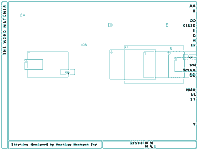Content Description
The Word Watcher is an application designed to support language education in secondary schools. By making pupils look at foreign languages form a different perspective than they are used to, The Word Watcher aims to raise the pupils' interest in learning foreign languages.
The Word Watcher shows the differences and similarities of the languages English, French, German and Dutch by visualising the properties of a sentence. The application runs through a text and checks it for special characteristics as it goes along. The found data is reflected in an animation on the screen.
The Word Watcher looks at the statistics of a language, in the same way a person sees a foreign language. The first thing one notices about a language are the differences of the use of letters, letter combinations, the use of accents and possibly the length of the words of this particular language compared to the mother tongue. Later one starts to recognise the most frequently used words. The Word Watcher shows these characteristics, and questions about the languages are answered. Does German really have the longest words? Are the four languages more different than we think?
The Word Watcher consists of two parts, a demo and an interactive game. In the demo, a part of the French book 'Le Petit Prince' and its translations in English, German and Dutch are shown next to each other on the screen. The juxtaposition gives new insights in the languages. The information from this demo can be used to beat the computer in the interactive game.
In the interactive part, the user can type in a sentence himself / herself. The Word Watcher creates the animation, based on the different units that occur in the sentence. While the user can say whatever he / she wants, in practice the language will conform closely to statistical rules. By researching the statistical properties of the entered sentence, The Word Watcher can conclude which language has been used. During the playback of the animation, points are counted for each of the languages. After that, the application gives its conclusion.
The natural reaction of the user is to try to find sentences that cannot be recognised. The smug responses from the computer make the urge 'to be smarter than The Word Watcher' even stronger. The user can also get some advice about the used language, and gets a better understanding of the outline of this particular language, so he / she might beat the programme the next time. By trying out different possibilities, the user can develop a basic understanding of the spelling in the different languages.


